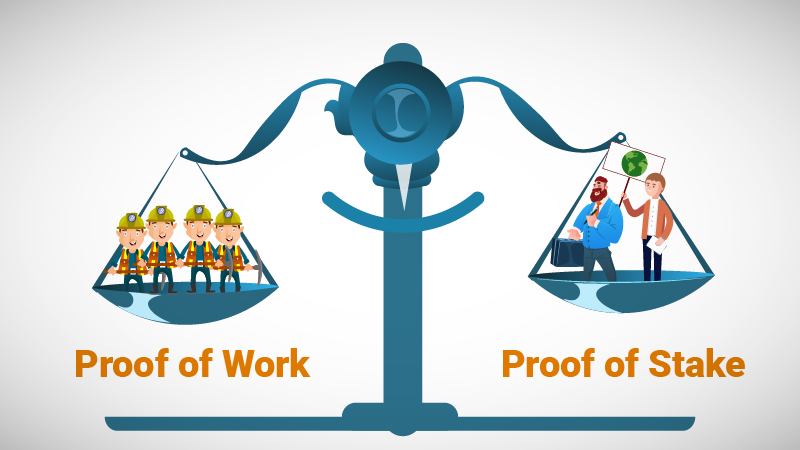Cryptocurrencies aim to streamline the process of various transactions. The fundamental feature of cryptocurrencies is that they are decentralized. From lending money to opening a new bank account, they want to Operate in a blockchain network. Proof of stake vs. proof of work gives the same results, also known as the “consensus mechanism.”
These two blockchain models lead the way and ensure transaction logic in cryptocurrencies trading. Recently, Bitcoin joined as a game-changer and overcame the flaws by using proof of work with many other cryptocurrencies like Ethereum, Bitcoin Cash, and Litecoin. The procedure to solve the complex cryptographic statement using computing power is known as proof of work.
An alternative method, proof of stake, came out in 2012, and a growing number of platforms like Avalanche, Solano, and Cardano are using this alternative method. One of the most important benefits of proof of stake is that it consumes much less energy than proof of work.
The main difference between proof of stake vs. proof of work is that one is known for security, and the other is known for speed. The consensus mechanism is trying to change the concept of business. Bitcoin uses proof of work to maintain the integrity of the blockchain. In the transaction process, they go through the security process in which Bitcoin Proof of work generates a hash of blocks for the miners.
The key difference between proof of stake vs. proof of work; overview:
Before starting the debate, we focus on the difference between proof of stake vs. proof of work. They both are mechanisms. A distributed network of participants can agree on which new block of the transaction should be added to a blockchain system of coins.
In proof of work higher,-powered computers are such complex problems, and cryptocurrencies miners compete with each other to overcome the issue. Cryptocurrency gives them the authority to add a new block of the transaction then they are awarded digital currency added to the blockchain.
The miners must deposit a stake as an authority in proof of stake before validating the transaction. The capacity of the validity block depends on the number of stakes the miners have put up for the pledge. The more coins they own, the more authority they are provided for mining. It requires network participants as collateral for new blocks they believe should be added.
In short, proof of work needs fast energy computer, efficient energy resources, and a process that slows down the transaction times. It is a form of transaction without the involvement of a third party. On the other hand, proof of stake is an alternative way of transaction that doesn’t require heavy computing power and is more scalable.
What is (POW) PROOF OF WORK?
In proof of work, the miners require consensus algorithms that help them to solve an equation by trial and error. Basically, proof of work requires an expensive computing system. It uses a high amount of energy to verify the miners’ received transaction in the form of coins as their compensation.
It is a competition among the blocks to know which new block has more crypto staked in its favor. For example, in Bitcoin, all the systems on the network are competing to be the first miner to resolve the problem and prove their work. They get to add the last batch transaction and earn some Bitcoin in exchange.
How does it work?
Pow requires nodes to provide evidence that they have expended. In practice, users employ hashes, long strings of numbers that operate as proof-of-work, to detect tampering. The hash function is a one-way function, which means it can only be used to verify that the hash data matches the original data.
The main strength of proof of work is the increasingly large energy investment, and we can say that energy consumption has become controversial and more difficult.
It requires a large amount of electrical power and causes a large amount of electricity wasting. Therefore, it is extremely difficult to alter any blockchain and makes it impossible to monopolize the processing capacity.
What is Pow used for?
Fundamentally, Pow is a decentralized consensus mechanism that requires members to solve arbitrary mathematical puzzles to prevent others from gaming the system.
It is also extensively used in cryptocurrency mining to confirm that miners calculate valid hashes to verify Bitcoin transactions. It plays a key role in security and preventing fraud. The security makes sure that miners won’t cheat about s transactions and develop trust. By increasing the difficulty of altering data over time, It is used to excerpt the Bitcoin’s transaction history securely.
Advantages of Proof of work:
- Security and dependability are the major features of proof of work. Due to the complexity of the mathematical equations, Manipulation of the system is impossible. The equations need verification that makes them more secure.
- Proof of work offers the best network that is more stable and decentralized.
- The only consensus mechanism has been proven on a scale.
- One of the main advantages of proof of work is its operating costs make it highly secure.
- Miners split their resources to sustain both blockchains. They motivate the miners to choose the secure side, which does not affect the network.
The disadvantage of proof of work:
- The main disadvantage of proof of work is that it requires increasing electricity.
- It generates a specific amount of e-waste that may not make it environmentally friendly.
- It is much slower and more scalable than proof of stake.
- Mining generates a lot of heat and might consume a lot of electricity depending on the miner’s location.
What is proof of stake?
Basically, it revolves around a process called staking, and it gives the power to validate transactions to those holding more network’s native currency. If we compare the proof of stake vs. proof of work, the proof of stake beats the proof of work when it comes to energy.
The proof of stake system is easier to participate in than the proof of work. Those miners with significant stakes in the system can’t manipulate it easily, and their stake will be destroyed if they do so.
In proof of stake, high computing systems and technology do not require. Even you don’t need stake in your hand. When you Operate in the pool and commit some of your stake in the pool, you will get rewards.
Proof of stake has more speed than proof of work. You can expect more than 100.000 transactions per second, which is much higher than proof of work.
What is Pos used for?
The consensus mechanism helps in validate the database entries and keep them secure. In other words, proof of stake helps secure the blockchain and maintain accurate information, and it uses algorithms that select who can add the next block of transaction.
Proof of stake is a method used for verifying cryptocurrency transactions. It utilizes an algorithm that determines who is eligible to add the next block of transactions to the chain based on the number of tokens possessed.
How does proof of stake work?
Proof of stake is generally a consensus algorithm and requires a portion of stake to validate the transaction. As a miner, you have to choose the block randomly, but you can get more advantages if you have a large stake. To verify the transaction, the chosen miners must agree. After that, when it is added to the chain, the miners receive a fee in cryptocurrency. On the other hand, if they don’t verify it properly, they can lose their stake.
Proof of stake allows only miners to validate miners, and in case they provide stake, they motivate the miners to explore illegal transactions to avoid forking the blockchain. The main feature of proof of stake is that it can prevent cryptocurrency attacks.
Proof of stake is more environmental because it uses less energy than proof of work. And can provide greater transaction than proof of work, in both speed and capacity.
Proof of stake offers greater scalability than proof of work. The transaction and blocks can be confirmed more quickly without any equations.
Advantages of Proof of stake:
- Proof of stake offers faster transactions with more scalability.
- It has much less environmental impact than proof of work.
- It provides economic incentives and approves the valid blocks.
- It is easier to use than proof of work because it doesn’t require technical computing systems.
- By adjusting the system’s parameters or amending its consensus method, the system can accomplish more transactions per second (TPS) than specific, current systems.
The disadvantage of proof of work:
- The biggest drawback is that you need to own a cryptocurrency It can be done by purchasing cryptocurrency using fiat money.
- Another disadvantage of proof of stake is that the stake holders can control the blockchain after owning more than 50℅ of the capabilities, which affects the security.
- It is considerably new and immature. Its security is not proven, and it needs to expand computational resources to get more popularity.
- Another disadvantage of proof of stake is that the reward is insufficient compared to mining.
Which is better? Proof of stake or proof of work:
Both Proofs of work and Proof of stake are two basic mechanisms that cryptocurrency uses to achieve consensus. Each of them offers their help to solve the problem of verifying a transaction without using the central authority.
The difference between proof of stake vs. proof of work represents that proof of work is still the main hero for stability and security. Although proof of stake avoids extra energy consumption, it requires more time for expansion. Therefore we can’t neglect the importance of both mechanisms.
Conclusion:
Proof of work is the king of security and decentralization, but proof of stake wins the game when it comes to speed. After observing the differences between proof of stake vs.proof of work, we can’t obtain any results from these blockchain consensus models; however, it may be possible that alternative models may gain more prominence in the future.

